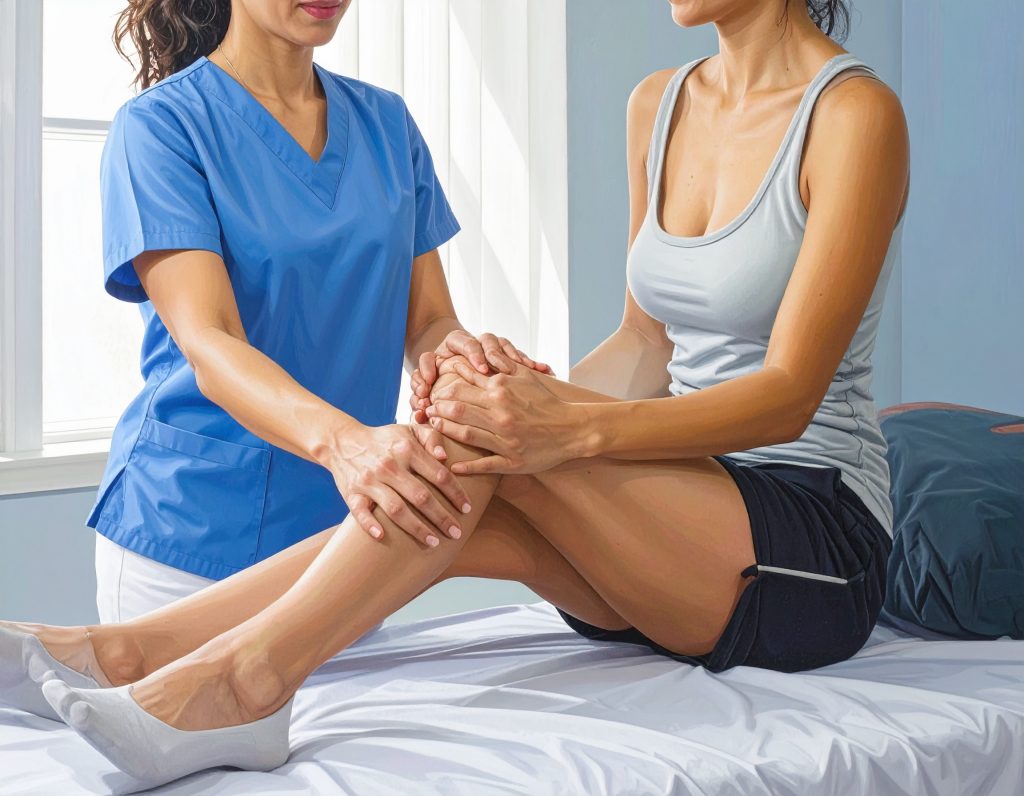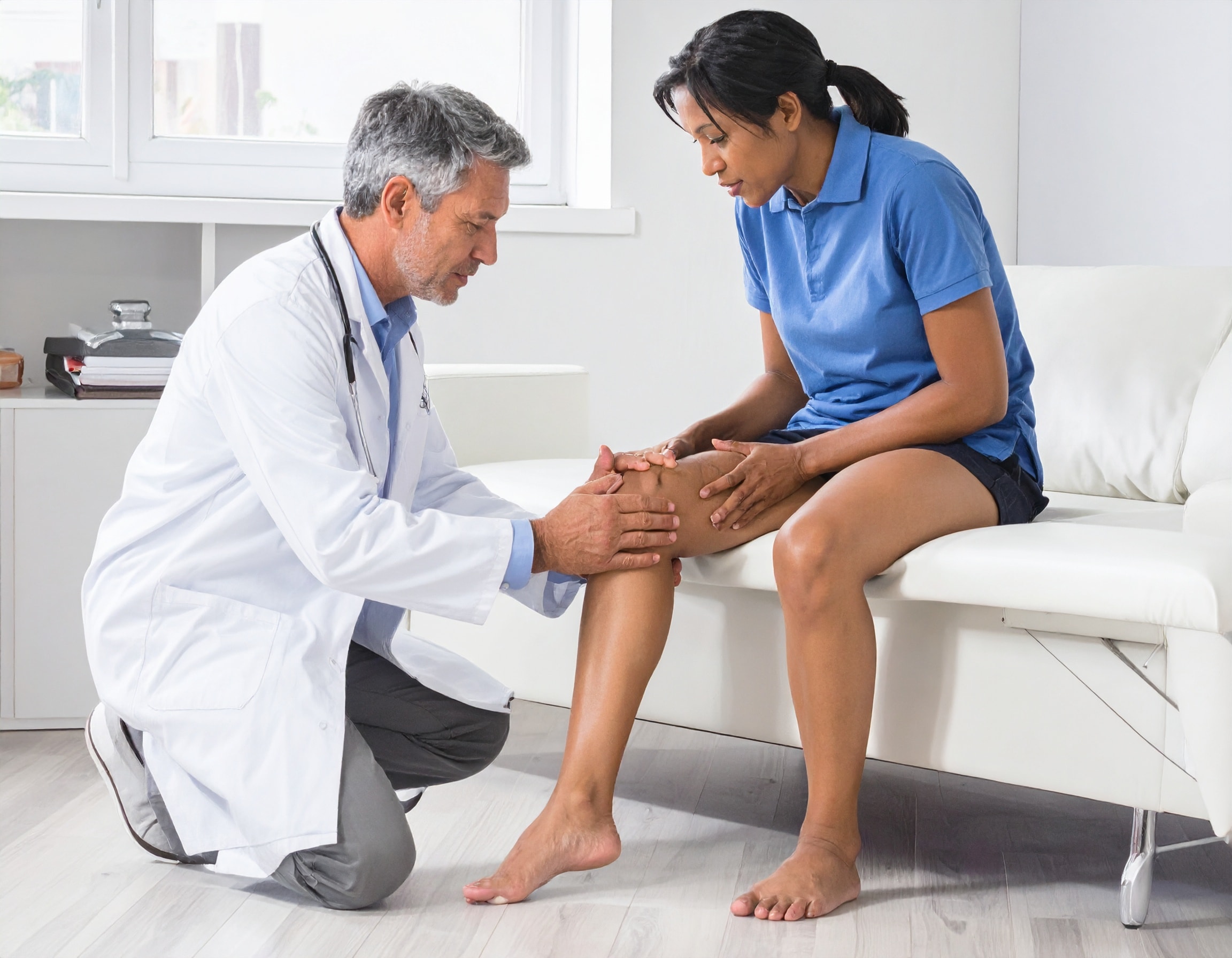Introduction to Knee Pain
Knee pain is common and can affect individuals at any age, often stemming from injuries, poor circulation, or conditions like arthritis. Connecting the thigh bone (femur) to the shin bone (tibia), the knee relies on surrounding thigh muscles for stability. These thigh muscles are crucial for supporting the knee and protecting it from injuries.
Knee pain can be temporary or chronic, with symptoms that often worsen with movement and improve with rest, making walking difficult. Cramps may also occur during activity, dehydration, or overuse.
Leg pain can arise from a variety of issues, such as cramps, injuries, or nerve problems. To treat knee pain effectively and prevent complications like stress fractures or varicose veins, it is essential to identify the cause and symptoms. Daily activities can be significantly impacted by injuries.
Maintaining a healthy weight and engaging in regular exercise, particularly thigh-strengthening activities, can reduce the risk of knee pain and related health issues, as recommended by the American College of Sports Medicine.
Knee pain may spread to the lower leg and is often accompanied by swelling, numbness, or tingling sensations in and around the knee.
Common Causes of Knee Pain
Injuries such as torn ligaments, ruptured tendons, or tissue damage can cause sharp knee pain and limited mobility. These injuries often result from accidents, falls, or sudden movements.
Arthritis, and especially osteoarthritis, is a frequent cause of knee pain in older adults. This condition leads to inflammation and reduced blood flow. Additionally, problems with the hips, legs, or ankles may also contribute.
Poor circulation, varicose veins, or neurological disorders that affect the nerves can contribute to knee pain. Blood clots in the leg require immediate medical attention. Nerve compression may also cause pain and restrict movement.
Overuse and repetitive strain injuries are frequent causes of knee pain, particularly among athletes and those who engage in regular physical activity. Injury prevention is possible by using proper exercise techniques. Sometimes, a small crack in the bone called a stress fracture develops from overuse, worsening if activity is resumed before healing.
A sudden, involuntary contraction called a muscle cramp may also cause sharp, sudden knee pain and reduced mobility. A cramp can occur due to dehydration or overexertion.
Other causes include conditions such as tendinitis or cramps.
Treatment may include rest, physical therapy, and medicines to manage symptoms. Regular exercising can help reduce the risk of knee pain.
Risk Factors for Knee Pain
Several factors raise knee pain risk. Extra weight strains knee joints, causing swelling, sharp pain, and more injuries or osteoarthritis. High-impact sports and repeated activities, like running or jumping, bring overuse injuries and joint discomfort. Poor blood flow and neurological issues worsen pain. Osteoarthritis and other arthritis forms also add risk. Keeping a healthy weight, exercising, and physical therapy help lower risk and support joint health.
Injuries that Cause Knee Pain
- Ligament sprains and tears cause knee pain, instability, swelling, and sometimes numbness, often limiting movement. These injuries often result in sharp pain and restricted mobility.
- Fractures and stress fractures cause severe knee pain and require immediate medical attention, rest, and physical therapy. Stress fractures are small bone cracks resulting from repeated impact or overuse.
- Dislocations and meniscal tears can lead to knee pain, reduced mobility, and often result in sharp pain and swelling.
- Knee surgery may be required to repair or replace damaged tissue and relieve pain in severe cases.
Thigh muscles are essential for supporting and stabilizing the knee joint.

Mechanical Problems that Cause Knee Pain
Mechanical knee joint issues disrupt function, causing pain, swelling, and limited movement. Causes include wrong kneecap tracking, ligament injuries, and misalignment from overuse, sports injuries, or muscle imbalance. Conditions such as iliotibial band syndrome and patellofemoral pain syndrome are common in athletes and can be managed with targeted therapy, exercises, or surgery. Early care helps prevent more injury and protects joint health.
Other Medical Conditions that Cause Knee Pain
Medical conditions like osteoarthritis and rheumatoid arthritis cause knee inflammation and pain. Gout and pseudogout produce sudden pain from crystal buildup. Poor circulation and nerve disorders may cause radiating pain, numbness, or tingling. Tendinitis and bursitis, involving tendon or fluid-filled sac inflammation, also cause pain and swelling. Proper diagnosis aids in effective treatment, which may involve medication, therapy, or surgery.
Symptoms of Knee Pain
- Aching pain and stiffness in the knee, especially in the morning or after activity, are common symptoms. Swelling or numbness may also occur around the knee.
- Swelling, redness, or changes in the skin around the knee often follow injury or overuse. These symptoms can limit your ability to move the knee.
- Limited mobility and stiffness, especially after sitting or standing, can occur with knee pain. Numbness or tingling may also develop. Clicking or snapping sounds in the knee after injury or overuse may cause sharp pain and further restrict movement.
- Radiating pain, numbness, swelling, or weakness in the lower leg or ankle can accompany knee pain. Problems in the lower spine may also cause these symptoms.
Complications of Untreated Knee Pain
Ignoring knee pain can lead to serious issues affecting mobility and daily activities. Untreated pain may become chronic, causing radiating pain to the lower leg, muscle cramps, numbness, and weakness. It can also increase the risk of blood clots and varicose veins, especially with poor circulation. The National Institute warns that persistent knee pain might indicate underlying health conditions requiring prompt treatment. Take action now by consulting a healthcare professional at the first signs of knee pain to prevent long-term joint damage and improve quality of life. Prioritize early medical attention to avoid complications.
Diagnosis of Knee Pain
- Physical examination and medical history can help diagnose knee pain, especially when combined with imaging tests and laboratory tests.
- Imaging tests, such as X-rays and MRIs, can help diagnose knee pain by assessing damage to tissue, bones, and joints, especially when combined with physical examination and medical history.
- Laboratory tests, such as blood work and joint fluid analysis, can help diagnose knee pain, especially when combined with physical examination and imaging tests.
- Arthroscopy can help diagnose and treat knee pain, especially when combined with physical examination and imaging tests.
- Verification of diagnosis through multiple tests and examinations can help ensure accurate diagnosis and effective treatment, especially when combined with rest and physical therapy.
Treatment Options for Knee Pain
- Pain relievers, such as acetaminophen and ibuprofen, can help alleviate knee pain, especially when combined with rest and physical therapy. Other medicines may also be prescribed to manage knee pain and address underlying causes.
- Physical therapy and exercise can help strengthen muscles and improve joint mobility, especially when combined with rest and pain relievers. It is important to maintain proper form during these activities to prevent further injury.
- Knee surgery may be necessary to repair or replace damaged tissues, especially in severe cases, and can be accompanied by rest and physical therapy.
- Alternative therapies, such as acupuncture and massage, can help alleviate knee pain, especially when combined with rest and physical therapy.
- Lifestyle modifications, such as weight loss and exercise, can help reduce knee pain and prevent future episodes, especially when combined with rest and physical therapy.
Preventing Future Knee Pain
Taking proactive measures can prevent knee pain and promote long-term joint health. Maintaining a healthy weight reduces stress on the knees and lowers the risk of injury and osteoarthritis. Regular low-impact exercises like swimming, cycling, and aerobics strengthen supporting muscles and enhance stability. A diet rich in calcium and vitamin D supports bone strength and helps prevent stress fractures. The American College of Sports Medicine recommends incorporating balance, flexibility, and strength exercises, such as yoga or Pilates, to protect against overuse injuries. It is important to listen to your body, take breaks, and stretch during repetitive activities. Adopting these habits and seeking medical advice when knee pain arises can reduce the risk of chronic issues and maintain joint function.
See Recommended Products

When to Seek Medical Help
- Severe knee pain that interferes with daily activities, especially after injury or overuse, requires prompt medical attention, rest, and physical therapy. Do not delay contacting a medical professional if you experience symptoms such as sudden swelling or redness, as these may indicate a blood clot in the veins of the leg and require immediate care.
- Sudden and severe knee pain, especially after trauma or injury, requires immediate medical attention. Symptoms such as sudden swelling or redness may indicate a blood clot and need urgent care.
- Knee pain that persists or worsens over time, especially after injury or overuse, requires medical evaluation. Sudden swelling or redness may indicate a blood clot needing immediate attention.
- Fever or redness around the knee, especially after injury or overuse, signals the need for medical attention, rest, and physical therapy. Call your doctor without delay if you notice these warning signs. Sudden swelling or redness may indicate a blood clot—seek medical help immediately.
- Difficulty walking or bearing weight on the knee, especially after injury or overuse, requires immediate medical attention, rest, and physical therapy. If you have trouble with balance or movement, visit your doctor as soon as possible to prevent further injury.
Living with Knee Pain
- Managing knee pain through lifestyle modifications and treatment options can help improve quality of life.
- Seeking support from healthcare professionals and support groups can help individuals cope with knee pain.
- Staying active and engaged in physical activity can help reduce knee pain and improve overall health.
- Practicing stress-reducing techniques, such as meditation and deep breathing, can help alleviate knee pain.
- Focusing on overall health and wellness can help individuals live with knee pain and improve their quality of life, especially when combined with rest and physical therapy.
FAQs
How do I decompress my knee?
- Lie on your back and gently straighten the knee, placing a rolled towel under the heel so the knee hangs slightly. Hold 20–30 seconds, relax, and repeat a few times to reduce pressure and ease stiffness.
What causes knee pain?
- Common causes include overuse, sprains or meniscus tears, tendonitis or bursitis, and arthritis (especially osteoarthritis). Less common causes include gout or nerve issues. Pinpointing the cause helps you choose the right treatment.
What is runner’s knee (patellofemoral pain)?
- It’s pain around or behind the kneecap, often from muscle imbalance, training errors, or kneecap tracking issues. Activity tweaks and targeted strengthening usually calm it down.
What is a meniscus tear?
- The meniscus is a cartilage cushion in your knee. A tear can cause sharp pain, swelling, or catching/locking. Rest, physical therapy, and sometimes surgery help depending on the tear and your activity level.
How is knee arthritis treated?
- Treatment may include weight management, activity modification, physical therapy, and medications; in some cases injections or surgery. A steady plan can ease pain and keep you moving.
When should I see a doctor?
- Get care fast if you can’t bear weight, your knee looks deformed, or you have sudden swelling, fever, or redness. If pain lasts more than a few days or limits daily activities, book an appointment.

